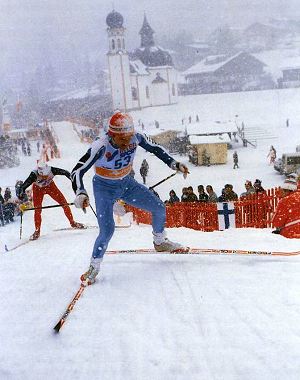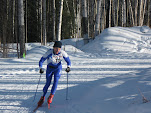Skate Revolution's Western Front - 1985
Ski Season 1985
After the excesses of 1984's season and resolved for a life of aceticism. Least of all, I had scientific and administrateive problems to solve in grad school where I was doing food habits research on captive elk, and that was after the immediate problem of just catching up to finish the spring semester in good standing. Over the summer and fall I attempted to run again but my 5 and 10k times were much slower than the previous year. That summer I also met Tamara, a lively CSU senior cross country runner at a concert, so that was one resolution scratched.
Skiing was not even on the agenda through the mild, snowless fall. But just before Christmas, Tamara and I headed out to Beaver Meadows, a small resort with about 10 km of tracks/trails, an hour out of
Tamara’s burst out in uncontrollable laughter as I showed her diagonal, double polling, and marathon skating. Was she laughing at my skinny legs covered by that silly green skin suit?
“I had never known that people could ski fast!” she later mused. “I had always thought that Nordic skiing was about plodding through deep snow.” We were instantly hooked and went skiing at every opportunity during break.
By January the snow had fallen in
Otherwise most things were much the same at the City Park loop, but the look of the tracks had transformed. Rather than the double groove classic track around the Firecracker Hill circuit, you would see an angled track jutting out a couple meters at maybe 30 degrees. Rather than double polling, we were marathon skating more and more. Pekka was still there too, and he was up to his old tricks. After making an appearance he would lock in behind for half a lap before we’d have to step aside and let him zoom past with a powerful diagonal stride.
All our January and early February races were along the Front Range on soft snow at Eldora or
At this time our technique was a mix. We’d diagonal or kick-double pole about half the time, marathon skate maybe 20-40% of the way, and use the diagonal V about 10% usually on the steeper climbs. By mid-season 1985 the skating revolution raging in Europe and in pockets of North America, including a few enclaves in the High Country of Colorado, like Gunnison,
In late February we ventured to the Western Slope and the Frisco Gold Rush, a 10k with 500 or 600 entrants, one of
Italian legend Marulio De Zolt leads a Norwegian skier at the 1985 World Championships in Seefeld, Austria. Both skiers are using the powerful V1 skate up the steep section.
Over spring break, I had two more races, a 10k in
“Why waxing my skis,” I replied, defensively but not knowing exactly why.
“No you should take off that kick wax and put on glider from tip to tail, and skate the whole way!” Heather responded.
I was incredulous. “What about the hills, how can I climb the hills?”
“It’s scary at first, and it takes a lot of commitment,” she replied. “You have to commit to skating the entire way, but it’s faster because you have such great glide.”
Commitment. Heather and Franz were engaged, so commitment must have been on their minds. I’d been with the same girlfriend for eight months, a record by half a year. If so, maybe I could commit to 10k with paraffin waxed skis.
With trepidation, I re-waxed those skis and resolved to skate the whole 10k. On fast spring snow over a rollicking course through lodgepole pines, meadows, and around a mountain lake, I marathon skated in hypoxic ecstasy to finish in 31 minutes, at least three or four minutes faster than would have been possible with kick wax.
You're Go-un The Wrong Way!
A couple days later I went for a ski with Franz and Bill Allen, who had also been on the elite circuit. We ventured to
If that weren’t enough Franz and Bill were doing something quite different. Rather than the single-pole diagonal V skate, they were propelling themselves with offset double pole skate.
Countless times the alpiners hollered, “You’re Go-un the wroonng way!!!” most with a strong
A few days later at the Turquoise Lake Classic at 10,400 feet near Leadville, I struggled with this new skate technique. Although no grandmas zipped by, I do recall diagonal V skating helplessly as a 98 pound high school girl, fresh off the medals podium at Junior Olympics, skated by easily using the alternating double-pole stride, later called V1. Nevertheless, the season had ended in a satisfying way, and I was already thinking about the next year.
Meanwhile Chris Hofer lead CSU to another solid shoing at the NCSA Nationalswhere he took 13th
place in the individual race. Interestingly, he reported that he and most of the skiers relied primarily on classic technique. We found this noteworthy because by then the NCAA and elite skiers had switched completely to skating.



0 Comments:
Post a Comment
Subscribe to Post Comments [Atom]
<< Home